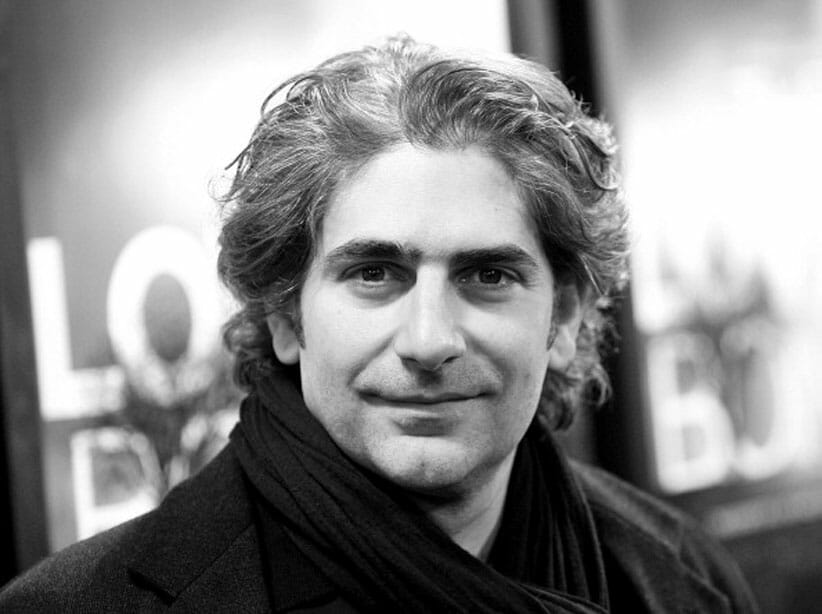
Michael Imperioli. Jim Spellman, Getty Images
It’s another precarious pandemic morning. Michael Imperioli materializes on the Zoom screen. He leads the group in prayer, purifying breaths and a sitting meditation. He reads aloud long passages by the Tibetan Buddhist Lama, Chogyam Trungpa Rinpoche. Within one of them it states, “For such a commitment is not at all about saving oneself, rather you have something to give sentient beings, you have evolved yourself spiritually enough so you can give what you have gained to others. That’s the purpose of the Bodhisattva vow, you yourself become a teacher, while remaining a student, you are going to be the guide for this tour, and you yourself are going to be a tourist.”
In a later conversation, Imperioli says similar but in his own words, “It’s hilarious that most of these people got to know me as this psychotic, murderous, drug addict, and now they want to sit and meditate with me…I mean, listen, fame is such a bizarre thing. If you can at least turn people on to something meaningful, something that may somehow be beneficial, that’s good.”
The causes and conditions that led Michael to the meditation cushion, began all the way back in the Italian working-class neighborhood of Mt. Vernon, NY. As a kid he saw epics like the Ten Commandments and King of Kings. At about 6 or 7 years old, he was writing, directing, and acting in his own plays, casting cousins in their backyard barbeque debuts. He was the first in his large Catholic family to go to college, except he didn’t… “The night before I was supposed to leave, they were going to drive me upstate, my bags are packed, my mom was giving me some money to start a checking account when I got up there, and I just said, ‘I don’t want to go. I really want to go to acting school.” Imperioli remembers, “It was very hard, and abstract for them, but they understood.”
Tendrel
Michael dreamt of attending the Lee Strasberg Theater Institute, like actors before him that he admired, but in a pre-internet era that was elusive. The family agreed he would go to college “in the city” while following his call. So the teen took a tour of Fordham at Lincoln Center, and NYU in Greenwich Village. Instead of taking a cab some 40 blocks to Grand Central he decided to walk back. He meandered down 15th Street where he saw Strasberg’s studio. Within those walls he met lifelong friends and creative collaborators like John Ventimiglia, Sharon Angela and Tom Gilroy. The 17-year-old became enraptured in the punk rebellion of 1980’s East Village. He went to raucous clubs off Canal Street, listened to Lou Reed, Patti Smith, Suicide, Television and early REM. He watched films by John Cassavetes and read books by Jack Kerouac. He hung around St Marks’ bookstore where he picked up a copy of the Buddhist scripture, The Diamond Sutra.
On Thursday afternoons actors would gather outside The Drama Bookshop to get a free flash of Backstage Newspaper so they could plan their service-job schedules around that week’s auditions. Michael repulses, “And you’d go to those horrendous auditions for sh*tty plays that didn’t pay any money. And your whole Saturday was just standing on line with literally hundreds of people for something they were putting up in some shi*thole that used to be a movie theater that they paid like a dollar to the city to buy.” For about six years the actor sustained the struggle, working as a cook, bartender, waiter, and busboy, voraciously studying, and refining his craft. He reflects, “In hindsight, those things are good I guess, because they build character and make you feel like you’ve earned something. And certainly, if you can go through those things unsuccessfully and not get the job and still persevere, and be really deluded about your own talent, to think that you’re going to succeed because the odds are so astronomically against success.”
Imperioli booked off-Broadway plays, and arthouse flicks. Mainstream audiences caught their first glimpse of him in John G. Avildsen’s film Lean On Me, about East Side High in Patterson. Yet it was in Martin Scorsese’s 1990 classic Goodfellas that Michael claimed his space in the mafia movie canon. The fresh-faced artist plays a small but pivotal role as Spider, a club attendant who gets callously killed by one of the leads. Some 30 years later he reflects, “Those scenes are really kind of where the story turns, where it becomes like, ‘Oh, wow, this is really sick.’” Michael’s performance left an impression on audiences and industry execs alike. He did the New York actor beat, with roles in Law and Order, Jungle Fever, Malcolm X, The Basketball Diaries and more. Casting directors like Sheila Jaffe and Georgianne Walken called him in to read for anything that he was remotely right for. Of this time Imperioli recalls, “In my 20s basically, all I did was pursue acting. Really, everything else took a backseat to it: relationships, friendships, family, everything. I was very, very, very, very driven towards that. I really wanted to be not just an actor but be successful.”
Karma
Like many New Yorkers, Michael didn’t have a driver’s license, which didn’t stop him from saying he did, to secure a part in an upcoming HBO pilot. His first day on set, he met co-star James Gandolfini. He reminisces through laughter, “I was driving him, and I didn’t know how to drive, and they made me back up, doing dialogue, talking to him, yelling, I did it like ten times, finally I smashed into a tree, the airbags go off, it’s a brand new Lexus, the cars all messed up, and I don’t know what’s going to happen if I’m gonna get fired. He’s sitting next to me I barely know this guy, and I look over and he just starts cracking up hysterically and I’m like, ‘Alright –this is gonna be ok.’ And you know from there, I’ve acted with Jim more than I’ve acted with any other actor, probably more than I will act with any other actor.”
That pilot of course, was The Sopranos. Creator David Chase’s brainchild that The New Yorker magazine lauded as, “Television’s greatest achievement”. It ran 6, 6 ½ or 7 seasons depending on who you ask, advancing the medium not only by giving rise to the beloved antiheroes of today, but by introducing gabagool to American audiences. The alchemy of the ensemble cast was once-in-a-thousand-lifetimes kind of stuff, like a Springsteen-style fable in which the hometown underdogs win the World Series.
Michael breathed being into “Christopha” Moltisanti, an up-and-coming soldier of The Sopranos crime, family, who would go to hell for his boss. While his heroin-addicted character dreamt of being a Hollywood screenwriter (“You f*%cking D-Girl…!”), Imperioli actually wrote 5 episodes. Those range from the subtle Italian humor of referring to the underworld as an Irish bar, to horrific scenes that still haunt commuters twice daily. The record-breaking series collectively acquired almost every industry accolade and honor. For his embodiment of Christopher Moltisanti, Michael Imperioli received an Emmy Award for Outstanding Supporting Actor in a Drama Series. In the live telecast speech he celebrated, “Being on The Sopranos is like the greatest thing in the world, for an actor. If this was the only thing I’d done, I’d be ok with that. Probably. To my collaborators on the show, you’re my family and my friends and I love every minute being with you guys. You’re the greatest and I love you all …”
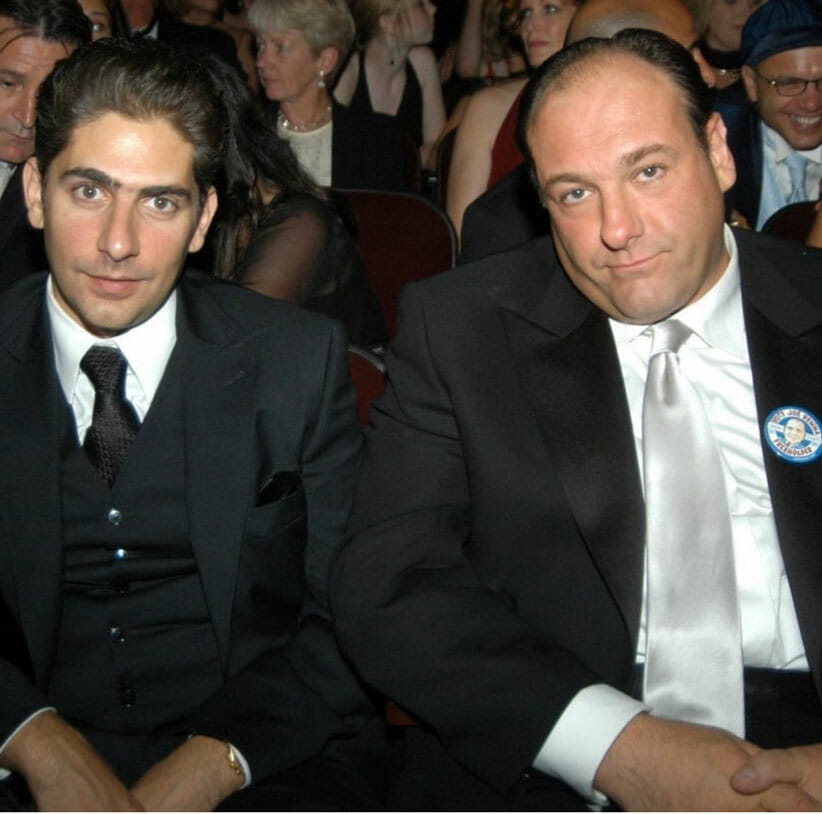
Michael Imperioli and James Gandolfini at the Primetime Emmy Awards, @realmichaelimperioli Instagram
That palpable love, friendship and artistic expression answered a lot of questions for early-Imperioli. The one who followed his heart, had it stomped on for years before attaining the Earthly achievements he worked so hard for. But this gave ground to new questions, different kinds, for which there was no road map. He explains, “I’m married, started having kids, got on The Sopranos, which was a wonderful job, and I started making some money, and getting known to the public and to the industry and peers. I had a good family life and friends, and creatively fulfilled. And yet, there was still something — I was still kind of miserable at one point and had a lot of bad habits. And started looking into very different diverse spiritual paths. I didn’t really know what I wanted. I wanted some kind of spirituality but I also wanted the magic.”
His first stop on the spiritual-shopping tour was the works of Carlos Castaneda, an iconoclast who made space for etheric-thinking in the late 1960s. Michael reflects, “I was fascinated by the fact that a guy in our modern times fell into this ancient tradition of mysticism that had been kept from most of the world, a lineage that was very mysterious and romantic for sure, but there was something about the training, and this guy giving himself over to a spiritual path in a way, challenging his own perception of the world, his perception of himself, his ego. I went through all his books, and it led me towards some other spiritual paths”. Those included Christian Science, the Russian mysticism of Gurdjieff and Ouspenskii, Hinduism, Theosophy, Occultism, and more. The seeker says, “I studied with a shaman from Panama, that was really my last stop before I found Buddhism, and I believe she had a lot to do with setting me on my path.”
Dharma
Michael and his wife Victoria followed the clues down an alley off Canal Street, he retells, “It was only a few blocks from where we lived. And when we went in, my wife and I realized it was an afterhours club in the 80s that we used to go to before we had met. It was like the most decadent, sex, drugs, and rock and roll place. And now it’s a Dharma center.” It was “Jewel Heart” a space dedicated to Gelek Rinpoche, a Tibetan Buddhist lama. Michael makes fun of himself, “ I kind of thought, ‘Well, now I’ll become Buddhist and everything will be ok. I didn’t really realize that there was work involved.”
Gelek Rinpoche gave Imperioli instruction for preliminary practices. He remembers, “I’m like 20 minutes a day, are you out of your mind?! There’s no way I’m going to be able to do this. There’s no way I’m going to be able to sit and meditate regularly. It’s not going to happen.” He didn’t yet know the old joke, “If you don’t have 20 minutes to meditate, you need 40.”. Or….that he was preparing to meet his teacher.
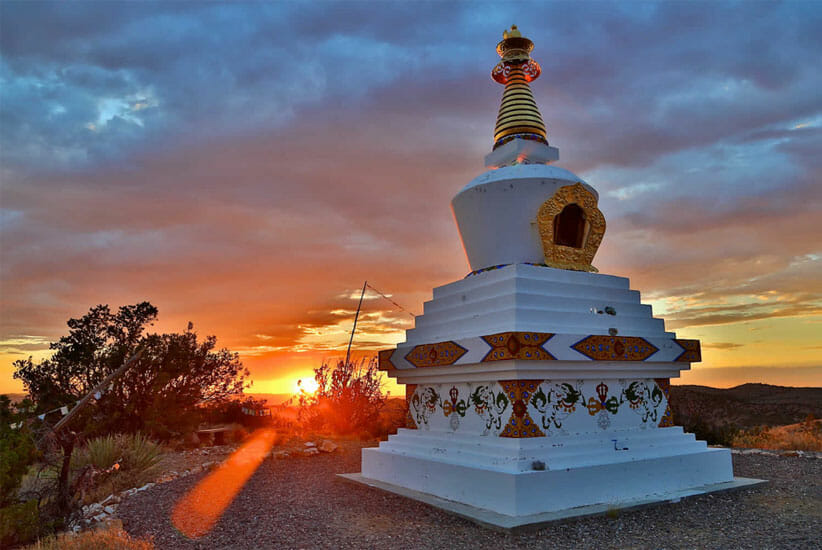
Garchen Institute Stupa, courtesy of Garchen Institute
Tibetan Buddhism
One of the tenets of Buddhism is the belief in reincarnation – that consciousness will re-enter the cycle of samsara (birth – life – death – rebirth) until it elevates out. In this tradition it’s quite common for lamas, monks, and other holy people to give clues to their loved ones about how to find them in their next lifetime. And for loved ones to look for their departed in the smiles of local youth. Such was the case when a young boy of 7, was recognized as his earlier incarnations in a Tibetan village in 1944. He was immediately entered into the monastery to receive the teachings and transmissions of His lineage in an unbroken succession. This being became known as His Eminence Garchen Triptrul Rinpoche. When He was 19 years old, He entered the requisite three-year spiritual retreat. However half-way through, His solace was broken. Communist China had invaded Tibet. They dropped bombs, shot meditating monks, sterilized women, and attempted to destroy all divinity in the country.
Buddhists take a vow of non-violence. However, there are causes and conditions in which the devoted are compelled to protect their three jewels: The Buddha, The Dharma (teachings) and The Sangha (community).
With this interest, the “Tensung Mak” was formed, an “Army for Protection of the Doctrine”. They fought for two years, likely enabling icons like His Holiness the XIV Dalai Lama of Tibet, Chogyam Trungpa Rinpoche, Gelek Rinpoche and others to escape to India. The Tensung Mak finally surrendered when a forest they were hiding in, was lit on fire. Garchen Rinpoche, and others of the army, were interned at a prison. They were tortured and starved leading many to suicide, “the suffering was inconceivable” a survivor later states.
Garchen Rinpoche kept His mind on The Buddhadharma, and when the occasional breadcrumbs came, He thought, “I should give my food away. If I’m going to practice generosity, I should practice it now.” On His deathbed, He was filled with so much anger, He spit in a guard’s face. They tied Garchen Rinpoche’s frail and failing body onto a coffin and carried Him into the infirmary. There, the same guard implored, “I am not angry, but I have a request. You are young and very sharp. Eat food.” The young Rinpoche resisted, “If I’m going to eat, you have to give me as much as I can eat. Then I’ll really eat. Otherwise I won’t eat at all.” The guards gave Him (and only Him), all the food He needed, and within a month, His malnutrition was healed. An older holy man, named Khenpo Munsel was transferred into the prison where Garchen Rinpoche was held. He mentored the young man in the deepest teachings of the dharma. Rinpcohe spent the next 20 years practicing these in secret and meditating in the middle of the night.
When Garchen Rinpoche was released in 1979, He saw His beloved homeland in tatters. Despite governmental threats, He spent the next 15 years traversing the countryside to comfort His impoverished and anguished people. He dried their tears, listened to their prayers, and restored the lost hope of many. In 1993 Garchen Rinpoche visited His Holiness the XIV Dalai Lama of Tibet in India. His Holiness praised Garchen’s devotion, resilience and compassion, bestowing the revered and sacred Bodhisattva vows upon Him.
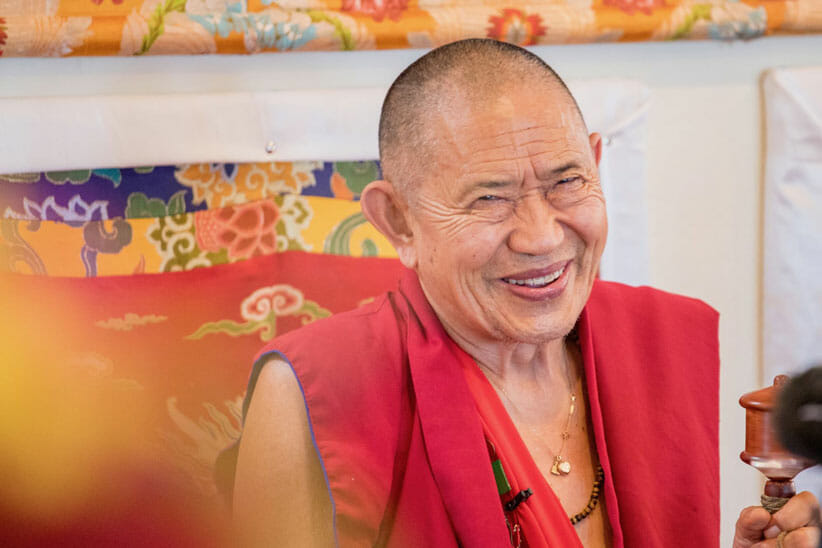
His Eminence Garchen Triptrul Rinpoche, courtesy of Garchen Institute
Taking Refuge
Back in TriBeCa in the 2000’s Michael and Victoria Imperioli had immersed themselves in the practice of Buddhism and opened their own dharma center. It’s there that His Eminence Garchen Triptrul Rinpoche entered their lives this lifetime. “He has the vibration of real flowing compassion, and it flows constant and unwavering.” Imperioli emotes. In July 2011, His Holiness the XIV Dalai Lama of Tibet was in Washington, DC leading a large-scale Kalachakra (empowerment ceremony) for World Peace.
In a nearby hotel room, The Imperiolis took refuge and received vows, from Garchen Rinpoche, making Him their root lama (main teacher). Michael was given the refuge name, Konchog Zopa Sonam. Konchog is a family name (passed down through the lineage), Sonam means, “auspicious’ and “Zopa”, well, Zopa is the Tibetan word for Patience. Something the actor well-known for seamlessly delivering speedy dialogue never gave much mind to. He recalls, “When I took refuge and He gave me the name He said, ‘The key to your practice is patience, because when you lose your patience you lose your love.’’ At first this wisdom didn’t quite land, but the immenseness of the observation has expanded within the practitioner ever since.

Victoria Imperioli, Garchen Rinpoche, Michael Imperioli and White Tara, courtesy of Michael Imperioli
Over the last 15+ years, Konchog Zopa Sonam has allowed his Bodhicitta (mind of awareness) to ripen. His edges seemed to have softened, his view widened. The driven young artist has actualized into one with knowingness. Groundedness. Majesty. Despite his initial defiance, he relies on his daily Shamatha sitting practice, and as permissible much longer meditation retreats. “Becoming Buddhist is a path to really wake up from delusion” he assures. The seeker is committed to his practice, his teacher, his Buddhanature, and most distinguished these days, being of benefit to himself and others.
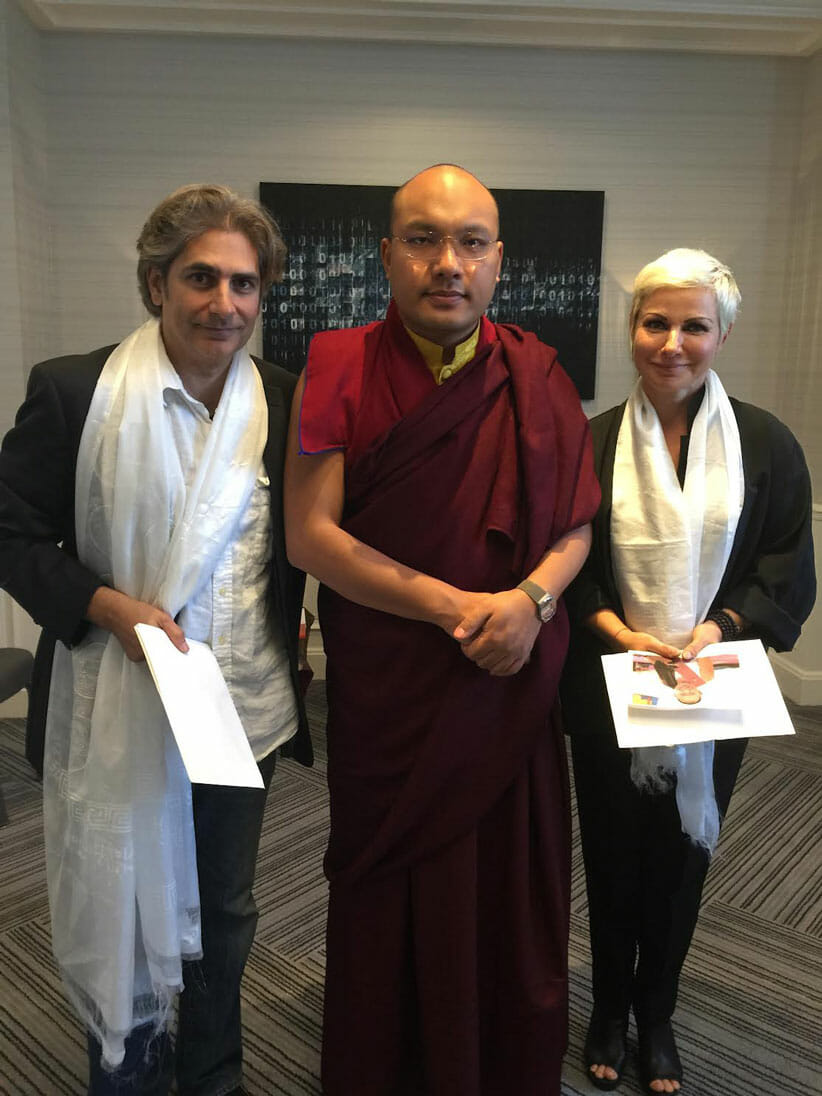
Michael Imperioli, His Holiness the XVII Karmapa Thaye Dorje and Victoria Imperioli, courtesy of Michael Imperioli
For The Benefit
In late 2019, something curious happened. Michael recounts, “I was really resistant to social media, and then I went on Instagram to help promote a TV show I was on. Then I realized, ‘Well, if I’m going to do it, I’m going to just turn people on to stuff that I like, art, music, movies, Buddhism.’ I started posting things about Buddha, and people started asking me how to meditate, and I would write back and give people meditation instructions. It was happening a lot, to the point where I was like, ‘Maybe I should make a video or something’. So, I asked my teacher, Garchen Rinpoche, I said, ‘A lot of these people that I’m communicating with want to learn how to meditate.’ And He said, “You don’t have to ask for my permission. If you want to benefit other people, go ahead and do it.’ I tried to do an Instagram Live session. It was a disaster. But through that, I met someone, and we started producing this Zoom webinar.”
The Zooms began as a simple seated mindfulness meditation. No talk of lamas or lineages, prayers or patience. Then there was a global pandemic, a social movement, an election, an insurrection, division, despair. The growing list of participants started asking Michael profound questions. They inquired about anxiety and depression, grief, dharma, karma, causes and conditions, sickness, suffering, old age and death. So he asked his teacher how to handle.
Garchen Rinpoche replied, “Just keep the focus on working with the mind. Because Buddha is not the name of a man, it’s the name of mind” With the calm candor, of a seasoned teacher, Michael relays this during an online meditation, “When you become aware of the fact you’re thinking, either go back to the breath, focus on where the breath is moving in and out of your nostrils right above your lip, or we use the visualization technique of the clear limitless unstained clear, blue, sky. The sky being the mind, the clouds representing the thoughts which arise from the sky and dissolve back into it. The third technique, which is a little harder, and usually takes a little more experience but you’ve been doing this a year now, is just by the fact of becoming aware of the thought, using mind to look at mind, to look at the fact that the mind is thinking, just let it be. And almost sink into that clarity of mind that recognizes it’s a thought…”

Michael Imperioli with Drupon Rinchen Dorje on retreat at Garchen Institute, courtesy of Michael Imperioli.
Bodhisattva
It’s now early 2022 – Michael’s Instagram account has become something of an online art-gallery where the masses come to learn about unsung cultural contributors; a curation that has been revered in magazines like Vice and GQ. His book, Woke Up This Morning with co-writer Steve Schirripa hit the New York Times bestseller list, and their Talking Sopranos podcast won a Webby. His punk band Zopa (sound familiar…?) released their debut album, and it’s just been announced Michael will co-star in the second season of Mike White’s HBO hit The White Lotus. Amidst all the excitement and activity, the father of three is complimented on his commitment to the digital Sangha that has developed; the group of students who religiously sign-on to sit with him. Michael deflects, “Yeah well, I’m happy to be there if people want to step onto this path. I’m not really – I guess I am kind of teaching, but I’m not a teacher. I’m more like a fellow student that has been around for a while and am kind of helping the other students out.”
“That’s the purpose of the Bodhisattva vow, you yourself become a teacher, while remaining a student, you are going to be the guide for this tour, and you yourself are going to be a tourist.”
This is the Way of the Bodhisattva.
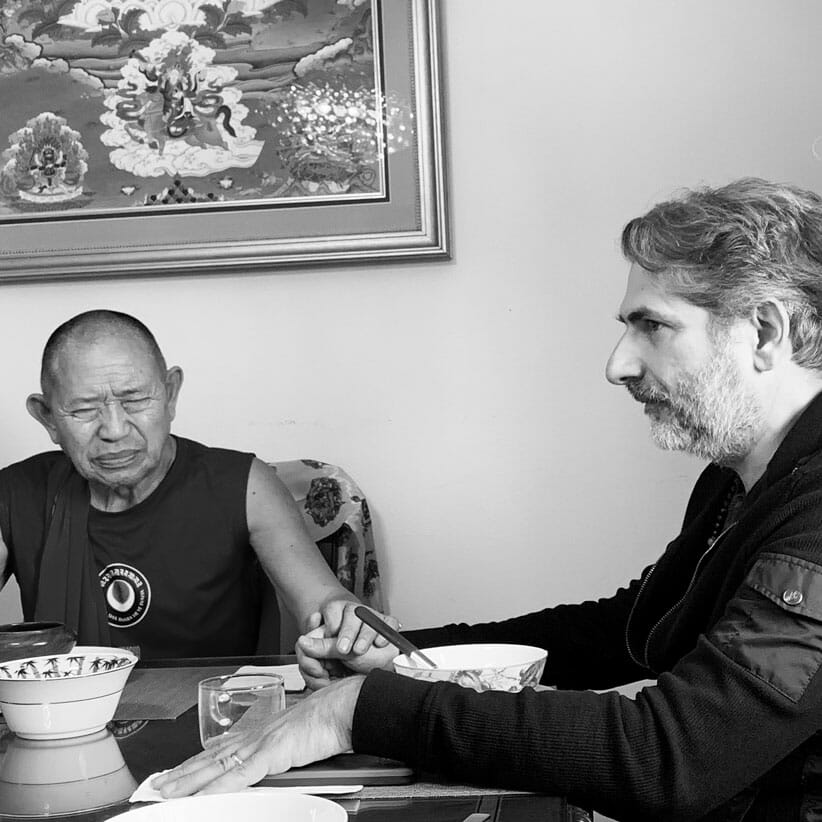
Garchen Rinpoche and Michael Imperioli, courtesy of Michael Imperioli
Zopa On Tour
Michael’s Band Zopa is on tour in California this week;
2/8 Zopa @ The Chapel – San Francisco – click here for tix + info.
2/9 Zopa @ Wayfarer – Costa Mesa/OC – click here tix + info.
2/10 Zopa @ Zebulon – Los Angeles – click here for tix + info.
To Learn More about Michael and Victoria Imperioli’s Zoom Meditations, check out his Instagram
@TheRealMichaelImperioli
To Learn More about Garchen Rinpoche go to: Garchen.net
To Check Out Amy’s Work Go To; Sense + Color, You Can Reach Her At IG: Amy_V_Dewhurst + AmyVDewhurst@SenseAndColor.co #PutYourGoodWhereItWillDoTheMost
